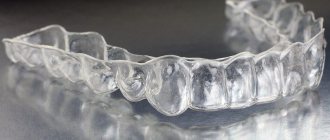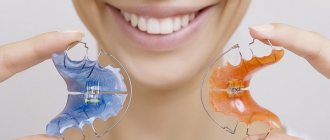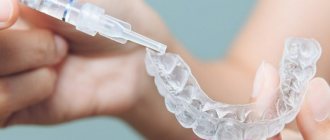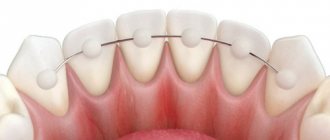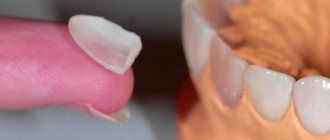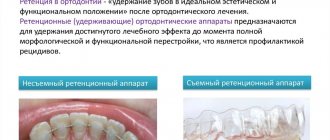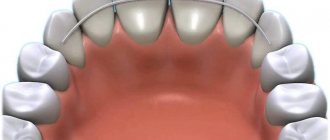Orthodontic treatment does not end when braces are removed. To maintain the results obtained by keeping the teeth in the correct position, patients have to wear a so-called retainer for some time. Today, there are various options for retention structures of removable and non-removable types, but due to the successful combination of functionality and cost, the most popular is the non-removable wire type. It is miniature in size and is attached to the lingual side of the teeth, remaining invisible to others. The type of retainer is chosen by the attending physician, depending on the clinical situation and the pathology of the bite.
Types of devices: which ones break down and come off more often
Several types of retention devices are used in orthodontic practice. Conventionally, they can be divided into removable [1] and those that cannot be removed from the mouth independently.
Removable devices
Removable types are represented by special aligners (not to be confused with aligners that straighten the dentition!). The cost of such mouthguards is low, about 3000-5000 rubles. They complete treatment in situations where it is impossible to install a permanent retainer. In some clinical cases (we will definitely consider them further), they can also act as an additional measure, and then they are used in conjunction with non-removable systems.
On a note! Rarely, removable devices such as trainers, plates and face bows are used as an auxiliary measure during the retention period. Typically, the need for their use arises when there are bite pathologies that need correction. For example, trainers are used for functional disorders and in order to form correct muscle memory.
The mouthguards are very aesthetic and easy to use. They are easy to clean and can be removed from the mouth when eating and brushing teeth. But not everyone likes the fact that the time the devices are in the mouth constantly has to be monitored. You must not forget to install mouth guards, for example, at night, and this requires a high level of self-control from patients, otherwise the entire result can quickly fade away.
You need to understand that such products simply cannot come off, since no one glues them to the teeth. The risk of their breakage is also low.
Fixed structures
In most cases, treatment results are consolidated using the second group of devices, which are non-removable. These are the ones that are fixed to the teeth using special glue and filling material.
The structures consist of stainless metal wire or other rigid material (fiberglass and nylon thread). They are fixed in pre-created grooves or recesses on the inner (lingual) side of the row. Or they are simply glued to the inner surface of the teeth (today this option is used more often).
Non-removable retainers are lightweight, compact, aesthetic, do not cause discomfort and do not interfere with the beauty of your smile, and are designed for a long period of use. That is why they are installed on a large number of patients. True, you have to get used to it, because... in the first few days the structure will interfere with the tongue.
Important! A non-removable retainer accompanies the patient while eating, brushing teeth, talking, sleeping; hygienic care of the oral cavity is difficult in it, so situations often occur when it comes off, falls off or bends.
How to properly care for devices
Removable items should be washed regularly with warm running water and cleaned with a toothbrush and toothpaste. Once or twice a week they need to be soaked in a special solution. To prepare it, you need to dissolve a tablet for dentures in a given volume of liquid and place the device in the resulting composition. Then rinse it with water.
If permanent retainers are installed after braces, then teeth are brushed as usual. Additionally, you should use irrigators, special brushes, and floss. These devices allow you to avoid the rapid deposition of plaque and stone. Toothpicks should not be used to remove food debris from under a metal wire - this will cause it to peel off.
Features of installing fixed systems
As a rule, fixed appliances are installed in the area of the front teeth. They capture the six anterior elements of the row (all incisors and canines), less often - only four incisors, but in this case they are complemented by a removable mouth guard, which we discussed above. This measure prevents the teeth from returning to their original position.
Fixed appliances are very rarely installed on molars and premolars due to the anatomical features of these teeth and the complexity of fixation. The only exceptions are those cases when the first and second premolars are removed during orthodontic treatment - then the structures are fixed in order to avoid the formation of cracks and spaces between units of the row.
What type of retainers to choose
Unfortunately, the patient's opinion is not taken into account when choosing a retainer. This is decided only by the orthodontist, based on the patient’s age, the condition of his teeth and many other factors that the client, without special education, is not even aware of. However, it is better to learn about the disadvantages of fixed and removable structures in advance.
Disadvantages of removable retainers:
- All removable retainers, with the exception of the mouthguard, are highly visible to others, and this makes the smile unaesthetic
- Wearing a removable retainer will likely cause increased salivation
- Affect a person's diction
- May cause irritation
- While using this design, you cannot eat, which means that every time you visit a restaurant or cafe, you need to retire to remove such a retainer and rinse your mouth. You always need to have a case with you where you can hide a mouthguard or record.
- It is necessary to carefully monitor the cleanliness of this structure
The advantages of wearing a removable design include ease of use.
Disadvantages of permanent retainers:
- The orthodontist must monitor the condition of this structure from time to time.
- There are times when such a device comes off, in such a situation you should immediately visit your orthodontist.
Perhaps, this is where all the disadvantages of permanent retainers end. Some inconveniences include the need for more careful hygiene.
The advantages of a non-removable structure include its complete invisibility to others. The patient quickly gets used to it, and even if in the initial stages of wearing it it may cause some discomfort and affect diction, then within a week all this goes away. Over time, the patient himself may forget about this device in his mouth, since the retainer is almost imperceptible.
How are permanent retainers installed?
Immediately before installing the systems, the specialist refers the patient to professional teeth cleaning, where all types of plaque are removed. Then an x-ray is taken to determine the position of the roots. And the installation process itself looks like this:
- the doctor creates small depressions or grooves on the inside of the dentition (if necessary),
- polishes the lingual surface (from the side of the tongue) and applies an etching gel to it,
- the tissues are thoroughly dried, treated with an adhesive composition, after which the retention wire is positioned,
- the wire is covered with a composite material on top,
- The composite is polymerized with a lamp, carefully ground and polished.
Features of the retention period
The duration of the retention period is determined by the orthodontist. The more global the changes in the dental system, the more time it takes to consolidate the result. Also, the period of wearing retainers is influenced by the condition of the dental system, how quickly the tissues adapt to the new position and other features. Most often, the retention period is twice as long as the period of active treatment. How to care for your teeth while wearing retainers or plates?
It is important to take good care of your teeth, just as you do while wearing braces. Metal overlays on enamel increase demineralization, causing soft plaque to accumulate more and tartar to appear.
To maintain healthy teeth, you need to visit the dentist every six months for professional cleaning and remineralization of the enamel.
At the same time, you need to come to the orthodontist for follow-up examinations: the doctor will adjust the retainer, if necessary. If the retainer comes unstuck or breaks, you need to go to the orthodontist as quickly as possible.
Reasons leading to non-removable appliances peeling off
Let's look at the main reasons why the retainer comes off.
Medical errors
Doctors themselves are often involved in the fact that the retainer comes off because they did not properly treat hard tissues before the procedure and after gluing the device. Placement of a fixed system is a very delicate job that requires accuracy and precision from the orthodontist[2].
If you make a mistake at one of the stages (poorly polish, dry and clean hard tissues, do not completely remove saliva and tissue fluid, install the system in the wrong place, apply filling material poorly), then a situation where the retainer, its edge or tip has completely peeled off - it's only a matter of time.
Important! If the structure is initially installed incorrectly, then it will bear a serious load, which will lead to the retainer breaking or bending.
The doctor’s mistake may consist not only in the violation of the technique of preparing the dentition for the installation of devices and in the incorrect positioning of the structures, but also in the fact that the specialist began the retention period ahead of time, that is, at the stage when occlusion pathologies are not completely eliminated.
Negligent attitude of the patient to the recommendations of the orthodontist
Situations where the tip of the retainer or its edge have come off often arise because the patient does not follow the prescribed diet or eats too hard and sticky foods.
Excessive zeal during oral hygiene, inaccurate and too aggressive use of brushes, dental floss, brushes, toothpicks, or lack of proper dental care are factors that lead to your retainers constantly coming off.
Important! According to statistics, devices located on the upper jaw most often come off and break. This occurs due to the inability to place the wire in a place where it would not come into contact with the antagonist teeth located on the lower jaw.
Caries and other dental diseases
If the retainer has come off and the tooth underneath it hurts, this may indicate the development of caries, pulpitis, or periodontitis. In this case, a carious cavity forms on hard tissues, the surface topography changes, and, accordingly, the quality of adhesion of the enamel to the structure and filling materials drops sharply. The problem can arise either due to the fault of the doctor who violated the rules of asepsis when installing the structures, or due to the fault of the patient who did not provide thorough hygienic care to the oral cavity while wearing retainers.
Important! It must be said that non-removable retainers are usually worn for a fairly long period (from 3-5 to 10-15 years). Poor oral hygiene can lead to bacterial plaque accumulating under and around structures, causing not only caries and its complications, but also inflammation of periodontal tissue (gingivitis, periodontitis).
It is important to emphasize that in those places where fillings are installed on the teeth, non-removable appliances, in principle, are fixed less well, so it is possible that they will periodically come off.
How long to wear retainers after braces
The duration of treatment is determined by the orthodontist. The exact period depends on the characteristics of the clinical situation, as well as factors influencing the duration of the rehabilitation process. This means:
- The complexity of the orthodontic treatment completed. Usually, if the therapy took a long time, then wearing retainers is long-term.
- Patient's age. The older a person is, the less susceptible the tissues are to correction and external influence. Some adult patients need to use retainers for many years.
- Bad habits, diseases that can affect the duration of wearing the device.
On average, the duration of using retainers is two periods of wearing braces. Some patients, having learned about this, decide that they can do without these systems. They enjoy their perfect smile and mistakenly believe that it will never change. You can’t think like that—without retainers, your teeth will start to move apart in any case.
How can you tell if your retainer has come off?
This is not difficult to do. The design may begin to cause discomfort, scratch the oral mucosa, and leave wounds on the tongue or palate. Patients who suffer from pathology often notice a strange crunching sound while eating food.
If you do not solve the problem, you will notice that in the place where the retainer broke, the tooth “moved away”, that is, it shifted to its original position, which it occupied at the previous stages of treatment. Doctors say that this phenomenon is more typical for the lower jaw, the incisors and canines of which can change their positions in just a few days. You can see in the photo what the oral cavity looks like when the retainer has come off and the teeth have begun to move back apart.
“I didn’t immediately notice that my retainer had come off. The wire is so thin that I didn’t even feel any discomfort. And I found out about the problem in a very interesting way: during one of my morning brushings I saw in the mirror that a gap had appeared between my teeth, which, oh my God, took me a year and a half to get rid of!!! True, the diastema was smaller than before, but still! This is very disappointing! Be more attentive to yourself and don’t think that because you wear retainers, you don’t need to control this process the same way as with braces. It’s necessary, and how!”
Tinka, review from gidpozubam.ru
Types of retainers
Removable retainers
There are several types of removable retainers:
- Plastic transparent mouth guards
- Metal arc
- Plate
The patient can wear removable retainers only at night or wear them during the day , this depends only on the doctor’s instructions. In any case, it is impossible to eat with such a design, therefore, if the patient must wear a retainer during the day, he needs to have a special box with him, where the retainer can be folded during meals.
What absolutely should not be done if a problem arises
- remain inactive for a long time: if the retainer comes off, how long can you walk like this? Doctors say that the maximum that is possible here is 2-4 days. If you ignore the problem for longer, the teeth will gradually begin to take the incorrect position that they occupied before the bite correction,
- glue the device yourself, especially using non-medical adhesives: you can cause damage to surrounding tissues, provoke an inflammatory process,
- tear off or cut off the loose piece,
- remove the device at home: you can damage your teeth, gums, and mucous membranes.
Tags
how the teeth accepted braces dental arch and teeth will accept the surfaces of the teeth on the sides of the teeth micro-movements of the teeth. systems dental surface surfaces of the teeth. tooth breakage or in the dentition. Correction of the bite from restoration of the bite follows restoration of the bite with braces Correction of the bite in braces course of braces begins removal of braces dental removal of braces usually bite with braces closure treatment with braces. treatment with braces . Braces to braces treatment process treatment process. treatment process. treatment results during treatment all during treatment with braces. results of treatment with braces. your treatment and treatment process treatment process
prostheticsalignerspricesrecordprosthesiscariesquestionservicesarticlebackreviewsremovalimplantationchildrenyourpromotionschildrencontactsverycrownsrestorationdiagnosticsgivedamonwhiteningimplantstelephonedataceramicpersonalsentandimplantsfree surgeryanalysischildrenasked
The best solution is a visit to the clinic
If the edge of the retainer has come unstuck, or the structure has completely moved away from the teeth, is bent and damaged, then you need to see your orthodontist as soon as possible. The specialist, depending on the situation, will re-glue the required fragment, or completely remove the device (if damaged or broken) and replace it with a new one.
How do you remove a retainer if it is broken or bent? Using a bur, the doctor carefully files away the glue and composite material, after which he removes the structure and prepares the surface of the teeth for installation of a new system (polishes, etches, dries).
If it turns out that the retainer has come off on one tooth or along an entire row, and this was due to bite pathologies that were not completely eliminated, then it is important to return to the pre-retention period, that is, again install stronger and more effective orthodontic appliances, for example, braces.
If caries is found under the structure, the orthodontist removes the device and transfers the patient to the hands of a dentist-therapist. After therapeutic manipulations, you can return to the orthodontist’s chair in order to fix the new structure.
Removable raters
Probably, the plastic mouth guard has the most aesthetic appearance among all removable retainers. The product is completely transparent and invisible to others during a conversation. Unfortunately, a mouth guard, like all removable retainers, can affect diction and must be removed while eating.
If the orthodontist allows the patient to wear a mouth guard only at night, then wearing it for a very long time will not cause any discomfort and may remain a secret even to those closest to you.
What to do
You can notice when the retainer comes off by the changed sensations - the part that has failed will begin to scratch the surface of the tongue, or a change in the structure of the structure itself will occur.
In addition, a barely noticeable crunch may appear when eating.
Of course, in this case you should contact your doctor as soon as possible.
However, do not panic if the retainer comes off in the evening, when it is no longer possible to get to the clinic.
The main thing is not to leave the problem unresolved and get an appointment in the next 3-4 days.
Under no circumstances should you try to tear off a piece of the loose wire on your own, as this can cause significant harm not only to the tooth with the broken filling, but also to neighboring units.
In orthodontic practice, the problem of the retainer coming off is quite common and there is nothing wrong with it. The main thing is to visit a doctor in a timely manner to correct the problem, so that the teeth do not have time to change their location. Otherwise, years of wearing braces may be in vain.
What should you not do when wearing it?
After installation, wearing a removable or fixed retainer requires compliance with rules similar to the use of braces. Forbidden:
- frequently consume hot drinks/meals, solid foods;
- smoking, chewing hard objects with teeth;
- leave the removable structure outside the case;
- store near heating devices, heating radiators;
- carry out independent repairs/removal of fixed restorations;
- change the wearing regimen prescribed by the orthodontist.
Purpose
A retainer is a simple metal structure, which is created using a stranded wire or arc.
It provides fixation of teeth to maintain their position after removal of the braces.
Modern orthodontists install retainers on the six front teeth (from one canine to the other). But there is a procedure when the retainer is attached to only four incisors.
This depends on the individual structure of the dentition and the degree of its initial curvature.
The material used to create a retainer must be rigid - to securely hold the teeth, and plastic - to give it the desired shape and maximum fit to the dentition.
Causes of relapses
- excessive tilt of the frontal group units and overstrain of the oral muscles;
- left “eights”, which, when erupting, cause displacement of organs;
- expansion between “threes” - the more it increases, the more rapidly it contracts after correction, which is fraught with crowding;
- rotation of teeth (rotations around an axis);
- violation of the norm for maintaining the natural shape of the mandibular arch - retention devices only in 50-60% of cases repeat its configuration - it tends to return to its original position after 10-12 years;
- jaw growth. If the correction is completed in adolescence, with the vertical type of growth against the background of an open bite, a relapse is possible, and the horizontal type causes a deepening of the incisal overlap with age, therefore such anomalies require observation until the patient is 20 years of age;
- unresolved deviations in the articulation of the tongue when chewing food and swallowing;
- poor quality correction. With severe crowding, no space was created in the row, which led to the units tilting forward; after correction, a significant gap remained between the lower/upper incisors, which caused the upper teeth to return to their original position.
To prevent relapse, you must follow all recommendations, maintain discipline, and see an orthodontist once every six months. If displacement cannot be avoided, the dentist will suggest suitable re-treatment options.
Conditions for successful retention
:
- identifying the causes and factors that provoked the orthodontic defect. If they are not eliminated in time, there will be no lasting result - the teeth will become crooked again;
- competent correction. An inadequate therapeutic regimen or errors when correcting a bite with a brace system can cause unstable location;
- optimal design of the retention system.
Orthodontic splint
Used for positional retention of teeth. After removing the braces and installing a permanent dental retainer, the dentist takes impressions from which a model of the mouthguard is made. The splint should be worn for several years, putting it on every night.
In most cases, the device is worn on the upper jaw, since the lower units change their position over 2-3 years, forming a functional closure.
Types of caps:
- standard. Mass-produced products can be used immediately after purchase. Disadvantages: they do not take into account the anatomy of the row structure, therefore they are not suitable for all patients;
- thermoplastic. They are mass-produced and are distinguished by their ability to adopt the natural structure of the series;
- individual. Effective, accurate, most comfortable, repeating all the positional features of the organs in the oral cavity.
